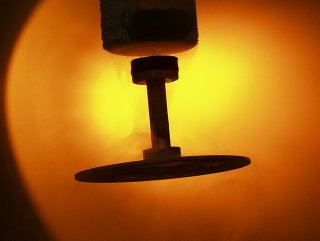
A set of prototype solar concentrators
installed in Lesotho.
(Courtesy of Amy Mueller.)
Matthew Orosz, an MIT graduate student advised by Harold Hemond, professor of civil and environmental engineering are working on alternative approaches to solar-based electricity that could significantly cut costs compared to photovoltaics panels. Their goal is to put the ability to harvest electricity from the sun into the hands of villagers in poor countries.
According to Kevin Bullis of MIT's Technology Review the system works like this: "The basic design of Orosz's solar generator system is simple: a parabolic trough (taking up 15 square meters in this case) focuses light on a pipe containing motor oil. The oil circulates through a heat exchanger, turning a refrigerant into steam, which drives a turbine that, in turn, drives a generator."
"The refrigerant is then cooled in two stages. The first stage recovers heat to make hot water or, in one design, to power an absorption process chiller, like the propane-powered refrigerators in RVs. The solar-generated heat would replace or augment the propane flame used in these devices. The second stage cools the refrigerant further, which improves the efficiency of the system, Orosz says. This stage will probably use cool groundwater pumped to the surface using power from the generator. The water can then be stored in a reservoir for drinking water."
"The design uses readily available parts and tools. For example, both the feed pump and steam turbine are actually power-steering pumps used in cars and trucks. To generate electricity, the team uses an alternator, which is not as efficient as an ordinary generator, but comes already designed to charge a battery, which reduces some of the complexity of the system. And, like power-steering pumps, alternators, including less-expensive reconditioned ones, are easy to come by."
"As a result, the complete system for generating one kilowatt of electricity and 10 kilowatts of heat, including a battery for storing the power generated, can be built for a couple thousand dollars, Orosz says, which is less than half the cost of one kilowatt of photovoltaic panels."
http://www.technologyreview.com/
read_article.aspx?id=17169&ch=biztech

 The Boeing Company has signed a contract to provide 600,000 solar concentrator cells to SolFocus, Inc., a California-based renewable energy company that is developing renewable terrestrial energy alternatives.
The Boeing Company has signed a contract to provide 600,000 solar concentrator cells to SolFocus, Inc., a California-based renewable energy company that is developing renewable terrestrial energy alternatives. 










 In the 19th century, Chicago architect Louis Sullivan coined the phrase "form follows function." Today, the
In the 19th century, Chicago architect Louis Sullivan coined the phrase "form follows function." Today, the 